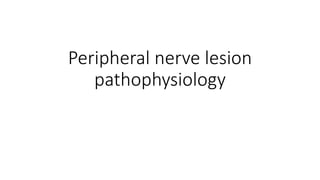PNL.pptx
•Descargar como PPTX, PDF•
0 recomendaciones•7 vistas
peripheral nerve injuries pathophysiology and classification
Denunciar
Compartir
Denunciar
Compartir

Recomendados
Más contenido relacionado
Similar a PNL.pptx
Similar a PNL.pptx (20)
Brachial plexus and peripheral nerve lesion { 1821-1830 }.pptx

Brachial plexus and peripheral nerve lesion { 1821-1830 }.pptx
Peripheral nerve injuries-ASSESSMENT AND TENDON TRANSFERS IN RADIAL NERVE PALSY

Peripheral nerve injuries-ASSESSMENT AND TENDON TRANSFERS IN RADIAL NERVE PALSY
Third nerve- functional anatomy and clinical features

Third nerve- functional anatomy and clinical features
Más de PrasannaChandiraling2
Más de PrasannaChandiraling2 (8)
Último
Último (20)
Story Board.pptxrrrrrrrrrrrrrrrrrrrrrrrrrrrrrrrrrrrrrrr

Story Board.pptxrrrrrrrrrrrrrrrrrrrrrrrrrrrrrrrrrrrrrrr
Russian Call girls in Abu Dhabi 0508644382 Abu Dhabi Call girls

Russian Call girls in Abu Dhabi 0508644382 Abu Dhabi Call girls
20240507 QFM013 Machine Intelligence Reading List April 2024.pdf

20240507 QFM013 Machine Intelligence Reading List April 2024.pdf
20240510 QFM016 Irresponsible AI Reading List April 2024.pdf

20240510 QFM016 Irresponsible AI Reading List April 2024.pdf
2nd Solid Symposium: Solid Pods vs Personal Knowledge Graphs

2nd Solid Symposium: Solid Pods vs Personal Knowledge Graphs
Vip Firozabad Phone 8250092165 Escorts Service At 6k To 30k Along With Ac Room

Vip Firozabad Phone 8250092165 Escorts Service At 6k To 30k Along With Ac Room
Tadepalligudem Escorts Service Girl ^ 9332606886, WhatsApp Anytime Tadepallig...

Tadepalligudem Escorts Service Girl ^ 9332606886, WhatsApp Anytime Tadepallig...
APNIC Policy Roundup, presented by Sunny Chendi at the 5th ICANN APAC-TWNIC E...

APNIC Policy Roundup, presented by Sunny Chendi at the 5th ICANN APAC-TWNIC E...
20240508 QFM014 Elixir Reading List April 2024.pdf

20240508 QFM014 Elixir Reading List April 2024.pdf
Indian Escort in Abu DHabi 0508644382 Abu Dhabi Escorts

Indian Escort in Abu DHabi 0508644382 Abu Dhabi Escorts
Best SEO Services Company in Dallas | Best SEO Agency Dallas

Best SEO Services Company in Dallas | Best SEO Agency Dallas
Local Call Girls in Seoni 9332606886 HOT & SEXY Models beautiful and charmin...

Local Call Girls in Seoni 9332606886 HOT & SEXY Models beautiful and charmin...
Top profile Call Girls In Dindigul [ 7014168258 ] Call Me For Genuine Models ...![Top profile Call Girls In Dindigul [ 7014168258 ] Call Me For Genuine Models ...](data:image/gif;base64,R0lGODlhAQABAIAAAAAAAP///yH5BAEAAAAALAAAAAABAAEAAAIBRAA7)
![Top profile Call Girls In Dindigul [ 7014168258 ] Call Me For Genuine Models ...](data:image/gif;base64,R0lGODlhAQABAIAAAAAAAP///yH5BAEAAAAALAAAAAABAAEAAAIBRAA7)
Top profile Call Girls In Dindigul [ 7014168258 ] Call Me For Genuine Models ...
PNL.pptx
- 3. PATHOLOGY Nerves can be injured by ischaemia ,compression, traction, laceration or burning. Damage varies in severity from transient and quickly recoverable loss of function to complete interruption and degeneration. There may be a mixture of types of damage in the various fascicles of a single nerve trunk.
- 5. Nerve injury and repair (a) Normal axon and target organ (striated muscle). (b) Following nerve injury the distal part of the axon disintegrates and the myelin sheath breaks up. The nerve cell nucleus becomes eccentric and Nissl bodies are sparse. (c) New axonal tendrills grow into the mass of proliferating Schwann cells. One of the tendrill will find its way into the old endoneurial tube and (d) the axon will slowly regenerate.
- 6. Nerve injury and repair
- 7. Introduction • Anatomy Peripheral nerves are made up of axon endoneurium Connective tissue perineurium epineurium Nerve trunks myelinated fibre unmyelinated fibre Myelin, protein-lipid complex function, insulating layer increase conduction rate
- 8. • Myelinated nerve are separated by nodes of Ranvier, at these points , the axons are bare. • Impulses jump from one node to the next --- Saltatory Conduction • Conduction in unmyelinated nerve is slower and dependent on the diameter of axon. axon Ranvier node
- 9. Cause: damage of cell body,axon, myelin sheath, connective tissue, blood supply Three basic processes 1. Wallerian degeneration 2. Axon degeneration 3. Demyelination
- 11. Neurapraxia Seddon(1942) coined the term 'neurapraxia' to describe a reversible physiological nerve conduction block in which there is loss of some types of sensation and'muscle power followed by spontaneous recovery after a few days or weeks. It is due to mechanical pressure causing segmental demyelination and is seen typically in 'crutch palsy', pres- sure paralysis in states of drunkenness ('Saturday night palsy') and the milder types of tourniquet palsy.
- 12. In Seddon's original classification, neurotmesis meant division of the nerve trunk, such as may occur in an open wound. It is now recognized that severe degrees of damage may be inflicted without actually dividing the nerve. If the injury is more severe, whether the nerve is in continuity or not, recovery will not occur. As in axonotmesis, there is rapid wallerian degeneration, but here the endoneurial tubes are destroyed over a variable segment and scarring thwarts
- 14. CLASSIFICATION OF NERVE INJURIES Seddon's description of the three different types of nerve injury (neurapraxia, axonotmesis and neurotmesis) served as a useful classification for many years. Increasingly, however, it has been recognized that many cases fall into an area somewhere between axonotmesis and neurotmesis. Therefore, following Sunderland, a more practical classification is offered here. First degree injury This embraces transient ischaemia and neurapraxia, the effects of which are reversible.
- 15. Second degree injury This corresponds to Seddon's axonotmesis. Axonal degeneration takes place but, because the endoneurium is preserved, regeneration can, lead to complete, or near complete, recovery without the need for intervention. Third degree injury This is worse than axonotmesis. The endoneurium is disrupted but the perineurial sheaths are intact and internal damage is limited. The chances of the axons reaching their targets are good, but fibro- sis and crossed connections will limit recovery.
- 16. • Distal axon degeneration, following section or severe injury, with degeneration of the myelin. The process occurs within 7-10 days of injury and this portion of the nerve is inexcitable electrically.